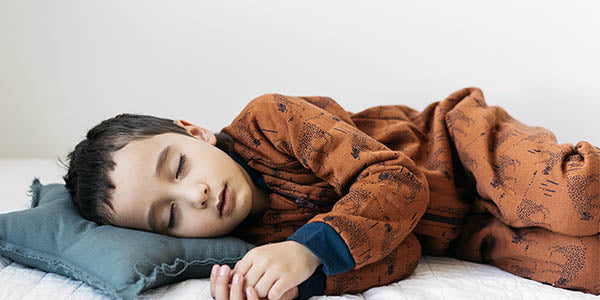
Child with night sweats and no fever – Here’s what you need to know to get better sleep
It’s stressful, worrying, anxiety inducing for a parent to find their child in bed feeling clammy with wet hair, a sweating neck and a wet pillow. A child with night sweats and no fever is even more confusing. But there is little to be worried about and things you can do to reduce sweating in most cases.
What causes night sweats in children?
If your child experiences night sweats, they’re not alone. A study carried out in 2012 analysed 6,381 children aged 7 to 11 years and found that almost 12 per cent of these children had night sweats every week.
Where an adult can regulate their body temperature, a child has difficulties. Children, particularly babies, are not yet fully developed, and interestingly, a child’s sweat glands are too big for their body and contribute to excessive sweating. This excessive sweat leads to a hot and clammy body, usually the culprit of children waking at night.
Beyond being very uncomfortable for the child, the moisture created by night sweats sits against the skin and causes the child to feel cold, even when dressed in warm layers.
But what causes the night sweats to happen in the first place? There are many causes, and it’s always a good idea to see your doctor if your child presents with any night sweating.
- Young children and babies haven’t yet mastered the art of keeping/putting their blankets on or taking them off and find it hard to regulate their temperature.
- The child’s bedding is too thick.
- The child’s sleepwear is made of a non-breathable material such as Polyester.
- The child could have had night terrors.
- The child may have an infection that causes the body to heat up as a protection mechanism.
- The child’s medication could be causing sweating.
- Extra body weight can cause over sweating.
- If your child is a fan of spicy food, that can be difficult for a child’s body to process.
- Your child might have sleep apnea and have trouble breathing while asleep.
- The child’s room is too warm.
- The child could have another illness such as hormonal disorders, diabetes, or hyperthyroidism.
If you are concerned, please consult your doctor.
While some reasons for night sweats require medical attention, there are quick and easy changes you can make to a child’s sleeping environment.
How to improve the sleeping environment if your child sweats a lot at night
Merino wool bedding and sleepwear
Please do yourself a favour and forget about blankets that never stay on. You don’t need them to keep your child comfortable. Instead, consider a Merino wool sleeping bag or wearable blanket sleepsuit. Your child won’t be able to kick it off like a blanket, and they will benefit from the natural properties of Merino wool, properties that will help with their night sweats. A sleeping bag made with Merino wool is not just any sleeping bag. A Merino wool sleeping bag acts as a child’s personal temperature regulator and reduces the risk of your child overheating and night sweats thanks to Merino wool’s complex natural fibres. It’s the gold standard of safe sleep.
How wool bedding and sleepwear help ease night sweats
Merino wool isn’t just a fibre you use in ultra-cold temperatures. It can be used in warmer months, too, thanks to its moisture wicking ability. As a hygroscopic fibre, wool releases and absorbs water vapour as the surrounding humidity increases and decreases. The wool achieves this process by transferring extra heat and sweat along the fibres, releasing them into the outside environment through evaporation.
Wool can absorb large amounts of moisture vapour, even before it turns into sweat, perfect for a baby or toddler sweating at night. Woolmark’s research found that wool can absorb up to 35% of its weight before feeling wet and clinging to the skin. In fact, one kilogram of dry wool can release heat equivalent to an electric blanket running for eight hours. Clever!
Merino wool’s impressive moisture wicking ability is what makes it so effective when it’s worn against the skin. The skin is where the moisture sits. As a general rule to combat sweating, use a Merino wool layer against the skin first, then add layers as it gets colder with a Merino wool sleeping bag or sleep suit on top.
Merino wool bedding and sleepwear just make sense. The absorption properties keep a child feeling warmer and drier. What’s clever about wool fibres is that while moisture is being absorbed or released, it doesn’t compromise the garment’s efficiency to keep a child warm or cool.
Fibres to avoid if you want to ease night sweats
Where woollen fibres are superior for absorption, heat and sweat release, there are certain common fibres you should avoid when buying bedding and sleepwear for children who experience night sweats.
Cotton – Cotton is valued for its breathability, lightness and ability to keep the wearer cool. However, it lets warm air escape quickly and is not a good insulator when wet with sweat. Cotton absorbs and holds sweat first and then releases it. Because it doesn’t wick away moisture straight away like wool does, it’s not as breathable and isn’t as good at keeping the wearer dry.
Polyester – Unlike wool and cotton, Polyester is a synthetic fibre that originates from the same petroleum-based products that make your sunglasses or your child’s plastic toy. Polyester bedding and sleepwear is water-repelling but not absorbent meaning that when a child sweats, the moisture is neither absorbed nor wicked away – it remains and can leave the child feeling wet, sticky and clammy, which is not great for night sweats. Polyester will not absorb sweat, making for a very uncomfortable sleep.
A note on heating
Understandably, parents may want to use something to heat a child’s room in very cold temperatures. However, rednose.org emphasises that monitoring the room temperature or leaving heating or cooling overnight is unnecessary, as long as the child is dressed appropriately for the room temperature.
This is where Merino wool bedding and sleepwear plays an important role. Merino wool works its magic with its fibres, minimising cold night sweats without the need for heating or cooling. Simply monitor the room temperature and monitor your child when there is a shift in temperature. You can do this by placing your hand on their chest or back to feel their skin to check if they feel warm and dry to touch or if they need a change in layering.
With the proper layering, your child will sleep soundly. A sound sleep thanks to the ideal conditions created by Merino wool that ensures children stay warm and their skin dry. Merino wool sleepwear is, by far, the safest way to keep a child comfortable, warm and free of night sweats.
